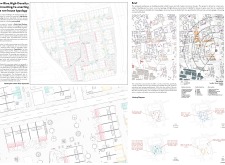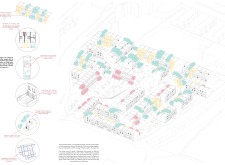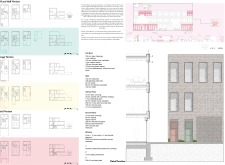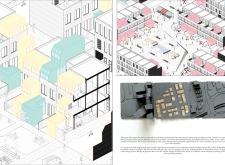5 key facts about this project
The design addresses the significant housing needs in London, located in Robin Hood Gardens, Tower Hamlets. It focuses on establishing a high-density, low-rise residential environment. The concept features narrow houses that can be expanded to accommodate changing family needs. This approach responds to overcrowding by providing flexible living spaces, allowing families and individuals to adapt without having to move away from their communities.
Housing Typologies
The development includes three distinct housing types. There are narrow houses divided into two apartments, which make efficient use of space. Additionally, some houses have private garages, offering convenience for residents. The mixed-use housing also incorporates retail spaces. This variety not only serves the residents but also enhances the neighborhood by integrating living, working, and communal functions.
Public Circulation and Accessibility
The design enhances pedestrian access throughout the area. It includes strategically placed access points that reduce street congestion, making the environment more walkable. Public squares are integrated into the layout, providing spaces where residents can gather and connect with one another. Smaller public areas designed specifically for residents contribute to a more engaging living experience, enhancing day-to-day community interactions.
Density Considerations
The proposed density for the development is set at 210 people per hectare before expansion, with the potential to increase to 270 people per hectare. This represents a significant increase when compared to the surrounding area's average density of 115 people per hectare. This careful consideration of density allows for more affordable housing options while still prioritizing the quality of life for residents.
The design successfully blends residential and mixed-use elements to create a cohesive living experience. Attention to these details reflects a commitment to addressing urban housing challenges. The final architectural expression encourages community interaction and achieves a balance between individual living spaces and shared public areas, fostering a welcoming neighborhood atmosphere.





















































